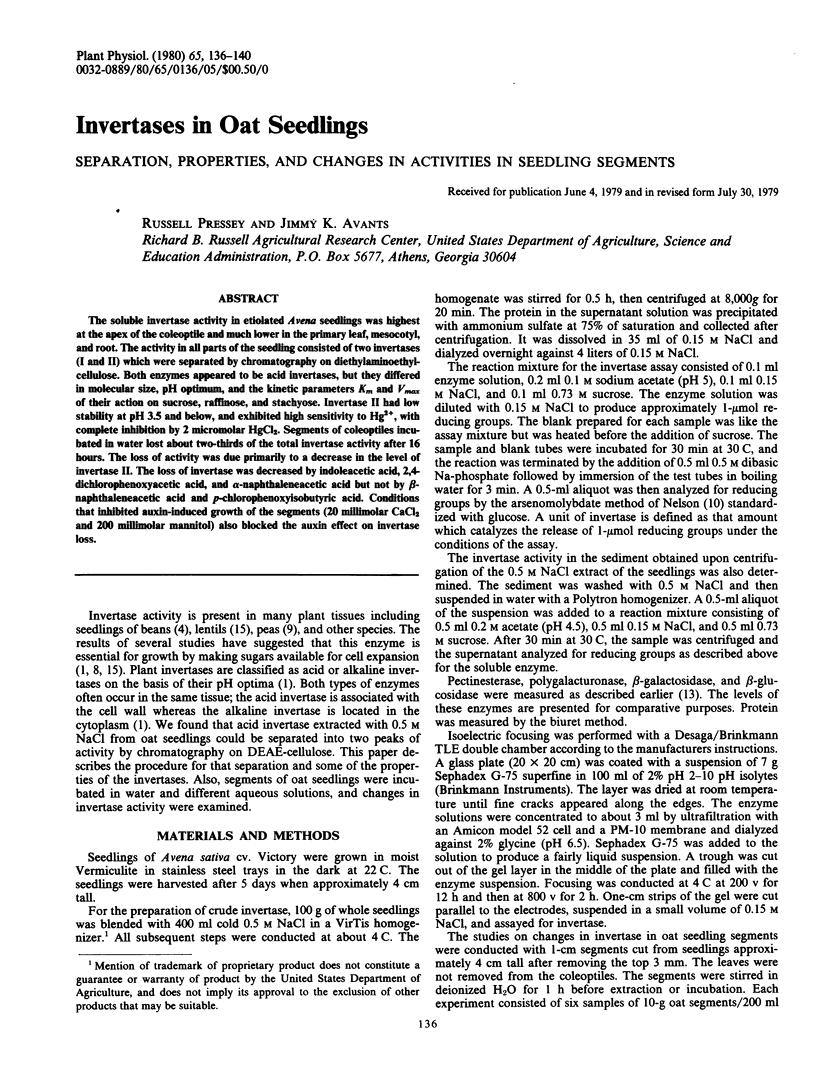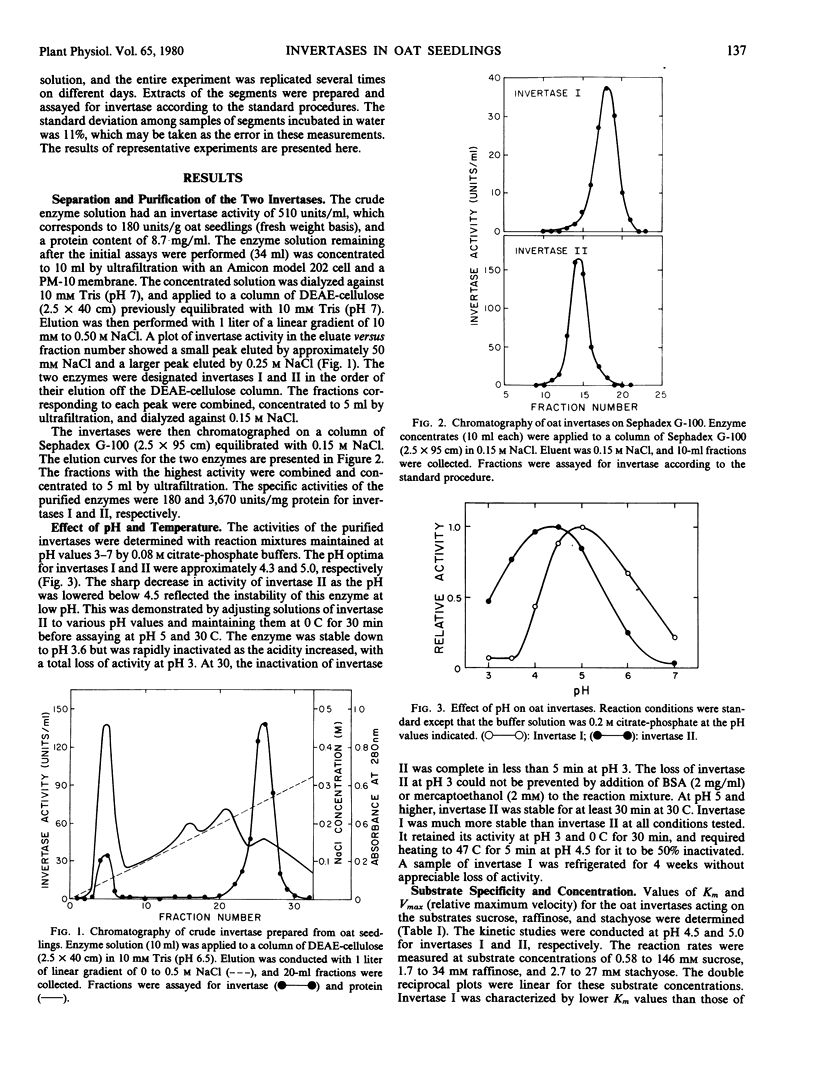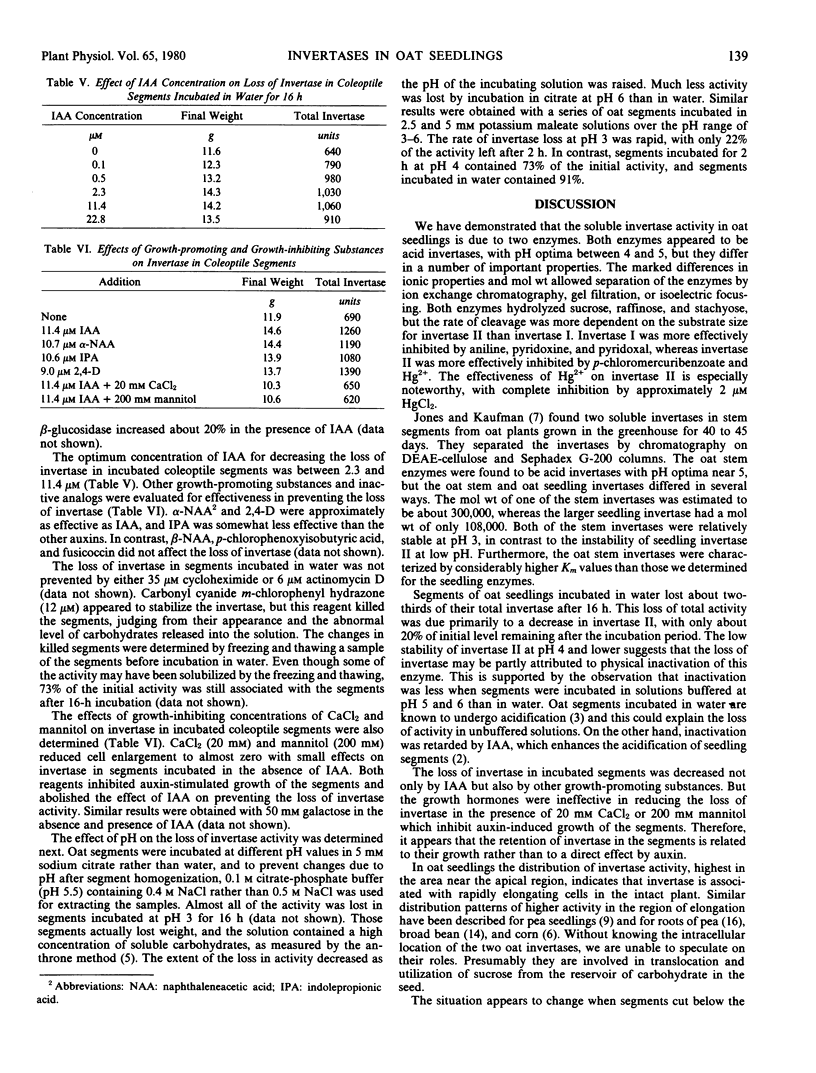Abstract
The soluble invertase activity in etiolated Avena seedlings was highest at the apex of the coleoptile and much lower in the primary leaf, mesocotyl, and root. The activity in all parts of the seedling consisted of two invertases (I and II) which were separated by chromatography on diethylaminoethylcellulose. Both enzymes appeared to be acid invertases, but they differed in molecular size, pH optimum, and the kinetic parameters Km and Vmax of their action on sucrose, raffinose, and stachyose. Invertase II had low stability at pH 3.5 and below, and exhibited high sensitivity to Hg2+, with complete inhibition by 2 micromolar HgCl2. Segments of coleoptiles incubated in water lost about two-thirds of the total invertase activity after 16 hours. The loss of activity was due primarily to a decrease in the level of invertase II. The loss of invertase was decreased by indoleacetic acid, 2,4-dichlorophenoxyacetic acid, and α-naphthaleneacetic acid but not by β-naphthaleneacetic acid and p-chlorophenoxyisobutyric acid. Conditions that inhibited auxin-induced growth of the segments (20 millimolar CaCl2 and 200 millimolar mannitol) also blocked the auxin effect on invertase loss.
Full text
PDF




Selected References
These references are in PubMed. This may not be the complete list of references from this article.
- Cleland R. Auxin-induced hydrogen ion excretion from Avena coleoptiles. Proc Natl Acad Sci U S A. 1973 Nov;70(11):3092–3093. doi: 10.1073/pnas.70.11.3092. [DOI] [PMC free article] [PubMed] [Google Scholar]
- Cohen J. D., Nadler K. D. Calcium Requirement for Indoleacetic Acid-induced Acidification by Avena Coleoptiles. Plant Physiol. 1976 Mar;57(3):347–350. doi: 10.1104/pp.57.3.347. [DOI] [PMC free article] [PubMed] [Google Scholar]
- Cooper R. A., Greenshields R. N. The partial purification and some properties of two sucrases of Phaseolus vulgaris. Biochem J. 1964 Aug;92(2):357–364. doi: 10.1042/bj0920357. [DOI] [PMC free article] [PubMed] [Google Scholar]
- Jones R. A., Kaufman P. B. Multiple forms of invertase in developing oat internodes. Plant Physiol. 1975 Jan;55(1):114–119. doi: 10.1104/pp.55.1.114. [DOI] [PMC free article] [PubMed] [Google Scholar]
- Kaufman P. B., Ghosheh N. S., Lacroix J. D., Soni S. L., Ikuma H. Regulation of invertase levels in Avena stem segments by gibberellic Acid, sucrose, glucose, and fructose. Plant Physiol. 1973 Sep;52(3):221–228. doi: 10.1104/pp.52.3.221. [DOI] [PMC free article] [PubMed] [Google Scholar]
- Pressey R., Avants J. K. Occurrence and properties of polygalacturonase in Avena and other plants. Plant Physiol. 1977 Oct;60(4):548–553. doi: 10.1104/pp.60.4.548. [DOI] [PMC free article] [PubMed] [Google Scholar]
- Pressey R. Inhibition of invertases by pyridoxal and its analogues. Biochim Biophys Acta. 1968 Jun 4;159(2):414–416. doi: 10.1016/0005-2744(68)90094-6. [DOI] [PubMed] [Google Scholar]
- Pressey R. Invertase inhibitor from potatoes: purification, characterization, and reactivity with plant invertases. Plant Physiol. 1967 Dec;42(12):1780–1786. doi: 10.1104/pp.42.12.1780. [DOI] [PMC free article] [PubMed] [Google Scholar]
- Seitz K., Lang A. Invertase activity and cell growth in lentil epicotyls. Plant Physiol. 1968 Jul;43(7):1075–1082. doi: 10.1104/pp.43.7.1075. [DOI] [PMC free article] [PubMed] [Google Scholar]


